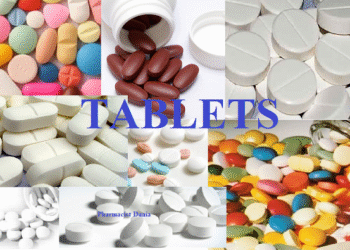Did you know that a single defective tablet could have serious consequences for a patient’s health? Tablets are one of the most common forms of medication, but they’re not immune to defects. As a pharmacist, it’s your responsibility to ensure that the tablets you dispense are safe and effective. In this article, we’ll explore the most common defects that can occur during the manufacturing and handling of tablets. By the end, you’ll have a better understanding of what to look out for and how to prevent these defects from occurring.
Discover the most common defects that occur during tablet manufacturing, their causes, impacts, and prevention methods. This guide offers valuable insights for healthcare professionals, students, and anyone curious about the production process.
Common Defects of Tablet Dosage Form During Manufacturing Process:
Tablet are one of the most widely used dosage forms, and their production involves various complex steps from formulation to packaging. However, despite the stringent quality control measures put in place by pharmaceutical companies, defects can still occur during manufacturing that could compromise the safety and effectiveness of the end product. These defects can impact the quality, safety, and efficacy of the final product, leading to financial losses for manufacturers and potential harm to patients. This article provides a comprehensive overview of the most common defects that can occur during tablet manufacturing, including their causes, impact on the tablets’ quality, and prevention methods. Whether you’re a healthcare professional, student, or simply interested in learning more about the tablet manufacturing process, this guide offers valuable information to help you understand and prevent tablet defects.
Tablet Manufacturing: Understanding Common Defects and Ways to Avoid Them
Tablets are one of the most widely used dosage forms, and their manufacturing process involves several complex steps. Even with the utmost care and attention to detail, defects can still occur during production that can have adverse effects on the tablets’ quality, safety, and efficacy. Therefore, it is crucial to promptly identify and address these defects to prevent their occurrence and ensure the production of high-quality tablets.
This article aims to provide an in-depth understanding of the most common flaws that can occur during tablet manufacturing, their impact on tablet quality, and ways to prevent them. Some of the problems that are commonly encountered during tablet manufacturing include capping, chipping, cracking, mottling, sticking, and picking.
The most Common Tablet Manufacturing Defects: Causes, Impact, and Prevention:
The article discusses common defects that can occur during the manufacturing process of tablets and how they can impact the quality and safety of the final product. The problems or defects of tablet which may arise during manufacturing are listed below:
1. Capping
2. Lamination
3. Chipping
4. Cracking
5. Mottling
6. Sticking
7. Double Impression
8. Friability
9. Weight variation
10. Hardness variation
1. Capping
Capping is a defect that occurs when the upper or lower part of the tablet separates horizontally from the main body. The separation results in the formation of a cap or a crown-like structure on the tablet’s top. The primary cause of capping is the use of excessive force or pressure during tablet compression, leading to air entrapment, non-uniform density distribution, and weak bonding between the tablet’s main body and its crown. Capping can also be caused by excessive air in the granulation, high tablet press speeds, or inadequate binding of the tablet’s ingredients.

Impact: Capping can lead to improper dosing and compromise the tablet’s effectiveness, as well as pose a potential safety hazard if the cap becomes dislodged and ingested separately. It can cause difficulty in swallowing, changes in the dose and drug release rate, and loss of tablet integrity.
Prevention: To prevent capping, the compression force should be adjusted to the appropriate level for the tablet’s formulation, and the binding agents should be added in the correct proportion to ensure adequate cohesion. Therefore, To avoid imperfections like capping, pharmaceutical manufacturers should optimize the compression force, use appropriate lubricants, adjust the tablet’s thickness and diameter, and ensure uniform tablet weight.
2. Lamination
Lamination is a defect where a tablet separates into two or more distinct layers, either horizontally or vertically. This can be due to inadequate bonding between the layers, caused by insufficient mixing or compression force. The issue may arise due to inadequate pressure during compression, poor formulation, excessive moisture in the granules, and high tablet speed during compression or by using a lubricant that is not compatible with the formulation.

Impact: Lamination can cause the tablet to break apart, resulting in improper dosing and reduced effectiveness. This error can result in inaccurate dosage or exposure of the active ingredient to air, moisture, or light, leading to decreased stability and potency. Lamination can cause changes in the tablet’s release profile. It can also lead to tablet breakage, dose dumping, and patient non-compliance.
Prevention: To prevent lamination, proper mixing of ingredients and adjusting the compression force to the appropriate level are important. Additionally, the use of appropriate binding agents can enhance adhesion between layers. Hence, one of the most common faults of a tablet dosage form such as lamination can be avoided by optimizing granule moisture content, use of lubricants, adjusting the compression pressure, and ensuring the tablet press is clean and properly maintained. Manufacturers should ensure the appropriate moisture content in the tablet formulation, optimize the blending and mixing process, and use uniform granulation techniques.
3. Chipping
Chipping is a defect that occurs when small fragments of the tablet’s edges break off during handling or transportation. So, Chipping is the breaking of the tablet’s edges or corners resulting in a rough or uneven surface. This occurs when the tablet’s edges or corners become chipped or broken.
 |
Impact: Chipping occurs when small pieces of the tablet break off during handling or transportation, resulting in the loss of the active ingredient and decreased potency. It can lead to the loss of the tablet’s dose, changes in the drug release profile, and decreased patient compliance. This defect can affect the tablet’s appearance. Additionally, chipped tablets can be difficult to swallow and may cause irritation in the throat or mouth.
Prevention: To prevent chipping, manufacturers should optimize the compression force, adjust the tablet’s thickness and diameter, and use appropriate packaging and handling techniques. The use of appropriate excipients, proper tablet design, and optimizing tablet hardness is important.
4. Cracking:
Cracking is a common defect that occurs during tablet manufacturing. It happens when a tablet breaks into two or more pieces due to excessive compression force or inadequate lubrication. The following are some additional details about the causes, impact, and prevention of cracking in tablets:
Causes:
– Excessive compression force during tablet compression can cause the tablet to crack.
– Inadequate lubrication during the compression process can also lead to cracking.
– The presence of air pockets in the tablet granulation can cause uneven compression, leading to cracking.
Impact:
– Cracking can affect the appearance and integrity of the tablet.
– Cracked tablets may not deliver the intended dose, leading to decreased efficacy.
– The risk of contamination increases if the cracked tablet coating is compromised.
Prevention:
– Proper formulation and compression techniques can help avoid excessive compression force and ensure uniform distribution of lubricant.
– Adequate lubrication during the compression process can prevent cracking.
– The use of suitable binders and excipients can help minimize the formation of air pockets in the tablet granulation.
By implementing the above preventive measures, manufacturers can avoid the occurrence of cracking in tablets and ensure that the end product meets the required quality standards.
5. Mottling:
Mottling is a common tablet defect characterized by uneven distribution of colors or speckles on the tablet surface. While it does not affect the drug’s efficacy, it can affect the tablet’s aesthetic appeal and lead to consumer complaints.
Causes: Mottling can be caused by several factors, including inadequate mixing of the granules or colorants, high moisture content in the granules, or inappropriate drying temperature. In some cases, the use of incompatible materials can also cause mottling. For example, if the colorant used in the tablet is not compatible with the excipient or the active ingredient, it can lead to uneven distribution of the colorant.
Impact: Mottling can have an impact on the consumer perception of the tablet’s quality, especially when the discoloration is significant. It can also lead to consumer complaints, as some people may associate the discoloration with an issue in the drug’s potency or effectiveness. Additionally, mottling may indicate an issue in the manufacturing process, which can lead to increased scrutiny by regulatory agencies.
Prevention: To prevent mottling, it’s important to optimize the moisture content of the granules, ensure adequate mixing of the granules and colorants, and monitor the drying temperature to ensure it’s appropriate for the specific formulation. Conducting compatibility studies between materials can also help identify potential issues with mottling before production. Additionally, implementing appropriate quality control measures can help catch mottling issues before they make it to market.
6. Sticking:
Sticking is a common defect in tablet manufacturing that occurs when the tablet material adheres to the punches or the die walls, leading to poorly formed tablets. In this article, we will explore the causes of sticking, its impact on tablet quality, and ways to prevent it.
Causes: Sticking can be caused by a variety of factors, including high tablet moisture content, inadequate lubrication, or insufficient release agent. For example, if the tablet material has a high moisture content, it can cause the tablets to stick to the punches or the die walls during the compression process. Similarly, if there is insufficient lubrication or release agent, the tablet material can also adhere to the punches or the die walls.
Impact: Sticking can have a significant impact on tablet quality. Poorly formed tablets may not contain the appropriate amount of active ingredients, resulting in ineffective treatment or even harm to the patient. In addition, sticking can also result in tablet damage, making them unsuitable for use or sale.
Prevention: To prevent sticking, it is important to optimize the moisture content of the tablet material, ensure adequate lubrication, and use sufficient release agents. One way to achieve this is to conduct regular checks of the tablet compression process to ensure that the tablets are forming correctly and not sticking to the punches or the die walls. Another way is to use specialized equipment that can monitor and adjust the process parameters, such as compression force and punch speed, to prevent sticking.
Example: A tablet manufacturing company was experiencing sticking issues with their tablet production. Upon investigation, it was discovered that the tablet material had high moisture content, which was causing the tablets to stick to the punches during the compression process. The company implemented a new drying process to reduce the moisture content and also adjusted the lubrication and release agents used in the production process. This resulted in a significant reduction in sticking defects and improved tablet quality.
7. Double Impression in Tablet Manufacturing:
Double impression is a common defect in tablet manufacturing that occurs when a tablet has two or more imprints or markings, resulting from a mechanical issue with the tablet press machine. In this article, we will explore the causes of double impression, its impact on tablet quality, and ways to prevent it.
Causes: The primary cause of double impression is the malfunction of the tablet press machine or improper adjustment of the punch and die. For example, if the punch and die are not aligned properly, or if the machine is not functioning correctly, it can result in double impressions on the tablet.
Impact: Double impression can cause confusion among patients and healthcare professionals, leading to incorrect dosing and medication errors. For instance, if a patient is instructed to take one tablet with a specific marking, but the tablet has a double impression, they may take more than the intended dosage or not take enough of the medication.
Prevention: To prevent double impression, manufacturers should ensure the proper maintenance and calibration of the tablet press machine, use appropriate equipment and tooling, and conduct regular quality checks during production. Regular maintenance and calibration of the tablet press machine can help prevent mechanical issues that can result in double impression defects. In addition, manufacturers should use appropriate tooling and equipment to ensure accurate and consistent tablet production. Regular quality checks can also help identify and address any issues with double impressions during the production process.
Example: A pharmaceutical company was experiencing double impression defects in their tablet production, resulting in confusion among patients and healthcare professionals. Upon investigation, it was discovered that the tablet press machine was not calibrated properly, resulting in a misalignment of the punch and die. The company implemented regular maintenance and calibration of the machine and ensured proper alignment of the punch and die. This resulted in a significant reduction in double impression defects and improved tablet quality.
8. Friability
9. Weight Variation in Tablet Manufacturing
10. Hardness Variation in Tablet Manufacturing
References:
1. US Pharmacopeial Convention. (2020). General Chapters: Tablets. In USP 43-NF 38. Retrieved from https://online.usp.org/usp-nf/revision-bulletins/tablets-r6
2. Vora, D., & Khatri, N. (2016). Common defects in tablet compression. International Journal of Pharmaceutical Sciences Review and Research, 37(2), 176-180.
3. Shah, N. H., Carvajal, M. T., & Patel, C. I. (2016). Tablet manufacturing: challenges and innovations. Journal of Pharmaceutical Sciences, 105(7), 2009-2014.
4. Breitkreutz, J., Boos, J., & Paepenmüller, T. (2018). Continuous manufacturing of oral solid dosage forms: a review. Pharmaceutical research, 35(8), 170.
5. Gohel, M. C., Jogani, P. D., & Bariya, N. H. (2004). Pharmaceutical manufacturing handbook: production and processes. Wiley-Interscience.
6. “Defects and their control in tablets” by Shashikant V. Nikam, et al. in International Journal of Pharmacy and Pharmaceutical Sciences (2011)
7. “Common tablet defects: Causes and remedies” by Amol P. Arora and B. G. Deshmukh in Journal of Drug Delivery and Therapeutics (2019)
8. “Common Tablet Defects: Causes and Remedies” by Saurabh Maan and Sanchit Sharma in International Journal of Research in Pharmacy and Pharmaceutical Sciences (2019)
9. “Tablet Defects and Remedies in Pharmaceutical Industry” by R. Jayachandra Reddy, et al. in International Journal of Pharma Sciences and Research (2015)
10. “Pharmaceutical Tablet Defects and their Remedies: A Review” by Abhishek K. Verma and Amrish Chandra in Asian Journal of Pharmaceutical Research and Development (2015)
11.https://www.ncbi.nlm.nih.gov/pmc/articles/PMC6032503/
12. Garti, N., Lapidot, N., & Harel, S. (2005). Tablet defects and their impact on clinical trials. Drug Development and Industrial Pharmacy, 31(10), 913-928. https://doi.org/10.1080/03639040500225281
13. Miller, J. M., & Lieberman, H. A. (2010). Tablets. In Pharmaceutical dosage forms: Tablets (pp. 3-28). Informa Healthcare.
14. Rees, J. E. (1993). Compression problems in tablet manufacture. International Journal of Pharmaceutics, 100(1-3), 15-23. https://doi.org/10.1016/0378-5173(93)90220-4
15. The United States Pharmacopeia and National Formulary (USP 44-NF 39), General Chapter <905> Uniformity of Dosage Units.
16. Duret, C., & Wibowo, C. (2013). Pharmaceutical tablet defects and their impact on clinical trials, part 2: Solved tablet defects. Journal of Pharmaceutical Sciences, 102(10), 3548-3555. https://doi.org/10.1002/jps.23622












